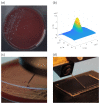Collaborative Robot Precision Task in Medical Microbiology Laboratory
- PMID: 35458847
- PMCID: PMC9025832
- DOI: 10.3390/s22082862
Collaborative Robot Precision Task in Medical Microbiology Laboratory
Abstract
This study focuses on the feasibility of collaborative robot implementation in a medical microbiology laboratory by demonstrating fine tasks using kinesthetic teaching. Fine tasks require sub-millimetre positioning accuracy. Bacterial colony picking and identification was used as a case study. Colonies were picked from Petri dishes and identified using matrix-assisted laser desorption/ionization (MALDI) time-of-flight (TOF) mass spectrometry. We picked and identified 56 colonies (36 colonies of Gram-negative Acinetobacter baumannii and 20 colonies of Gram-positive Staphylococcus epidermidis). The overall identification error rate was around 11%, although it was significantly lower for Gram-positive bacteria (5%) than Gram-negative bacteria (13.9%). Based on the identification scores, it was concluded that the system works similarly well as a manual operator. It was determined that tasks were successfully demonstrated using kinesthetic teaching and generalized using dynamic movement primitives (DMP). Further improvement of the identification error rate is possible by choosing a different deposited sample treatment method (e.g., semi-extraction, wet deposition).
Keywords: MALDI; colony picking; kinesthetic teaching; learning from demonstration; mass spectrometry; sub-millimetre accuracy.
Conflict of interest statement
The authors declare no conflict of interest.
Figures





References
-
- Leber A.L. Clinical Microbiology Procedures Handbook. John Wiley & Sons; Hoboken, NJ, USA: 2020.
-
- Dadoun R. Case study: Automation’s impact on productivity and turnaround time. MLO Med. Lab. Obs. 2002;34:36–38. - PubMed
-
- Bizzini A., Durussel C., Bille J., Greub G., Prod’Hom G. Performance of matrix-assisted laser desorption ionization-time of flight mass spectrometry for identification of bacterial strains routinely isolated in a clinical microbiology laboratory. J. Clin. Microbiol. 2010;48:1549–1554. doi: 10.1128/JCM.01794-09. - DOI - PMC - PubMed
MeSH terms
Grants and funding
LinkOut - more resources
Full Text Sources

